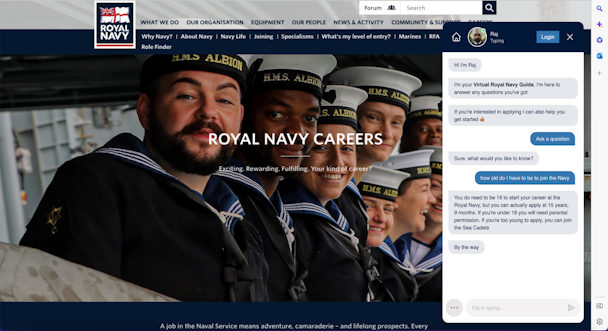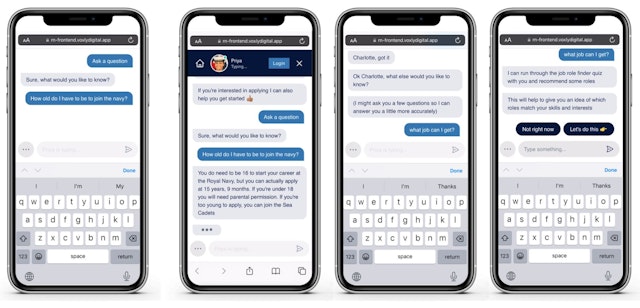Why the Royal Navy is experimenting with an AI-powered recruitment bot
The Royal Navy has a new tech tool to deploy in its latest recruitment drive – a conversational AI tool.

The recruitment chatbot is an early example of how DE&I can be baked into AI-powered consumer interaction / Royal Navy
The recruitment process for the Royal Navy is lengthy and involved, as you’d expect. Over the course of months, applicants will have many questions about what a career in the Navy will look like for them personally. With limited resources, the Navy can only respond to so many queries, which potentially limits the number of applicants who will ultimately go through the process.
In order to solve that problem the Royal Navy partnered with Wavemaker to develop and deploy a conversational AI tool. The Royal Navy Virtual Guide will provide applicants with individually tailored journeys, content and nudges as they navigate the application process.
Wavemaker UK’s head of innovation Rozzi Merrington explains that the AI surfaces information in a way that would be overwhelming were it just on the Royal Navy website: “It’s impossible to put all of that on a website in a way which is not going to completely overwhelm and crash servers every time. People want, and particularly Gen Z, want that hyper-personalization.
“So the benefit for our Navy is we’ve got all of this information. If we use a tool like this, we can deliver just the right information to the right person at the right time, which makes everything so much more efficient, but actually creates much more of a deeper connection, and much more sort of engagement with candidates over time.”
She also notes that for many applicants, the conversational nature of the AI combined with its synthetic nature ensures that applicants can ask questions that would potentially be uncomfortable between humans. She cites a potential situation in which a woman applying has questions about menstruation during an exercise that she might be unwilling to bring up to an older male.

The bot also allows for DE&I to be baked into the recruitment process. Merrington explains: “We know the type of questions that, you know, people, people from different ethnic backgrounds, or different sexual orientations, or women, for example… they’ll have different concerns and worries than maybe what you think the typical candidate looks like. So we wanted to make sure that we actively baked in checkpoints in our design process to ensure the content we were designing actively answered those questions, as much as it answered the standard questions.”
For brands, there are opportunities there to surface information in a way that is relevant to and comfortable for the user. Research from other companies including Meta has demonstrated that, when the synthetic nature of AI is made clear, consumers are happy to interact with them.
Future conversation
Merrington says that, given the rate of conversational AI development over time, there are few set-in-stone KPIs for their use. However, from the work Wavemaker has done with the Royal Navy on this campaign, she believes that engagement over time will ultimately be one of the most important considerations:
“If you’re an e-commerce brand and you want to use an AI solution to drive really rapid conversion or loyalty, then maybe engagement becomes important. But it’s not necessarily engagement in one session – it could be overtime. You have to flex the KPIs based on what you as a brand are looking to achieve.”
She also points out that brands looking to use conversational AI need to think of its as constantly iterating projects, rather than simply a one-off execution. As the needs and interests of the public change, so too will the information they seek from chatbots, and the platforms on which they choose to interact with them. Additionally – as with the Royal Navy project – their use will allow brands access to real-time user data that will allow them to refine some of their onboarding and sales processes.
The Royal Navy project is still in the early stages of development. Paul Colley, its head of marketing, said: “Solutions like our new AI Virtual Guide allow us to communicate in a 1:1 way for our website visitors, delivering the right content, to the right person, at the right time. And we’re only at the start of an exciting roadmap. Our ambitions for this solution are long-term, and I look forward to seeing its capabilities developing over time.”
For Merrington, the long-term viability of conversational AI is predicated on its ability to evolve alongside user habits. While large language models allow for the surfacing of information at scale, brands still need to consider the context in which users will discover and interact with them. She notes that while ChatGPT has brought the potential for conversational AI home for many brands, there is still a lot of education to be done when it comes to brands actually deploying them. We are still, she says, in a space of widespread experimentation.

